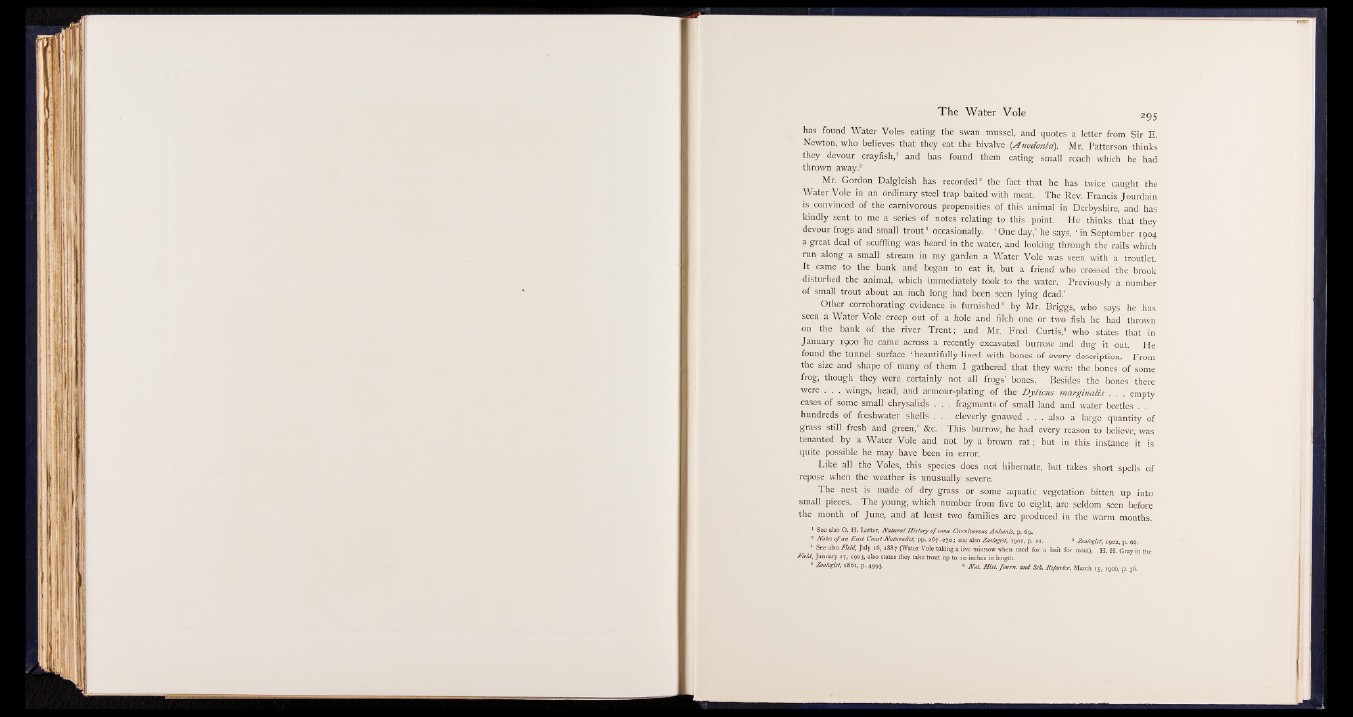
has found Water Voles eating- the swan musiÿj, and quotes a letter from Sir E.
N o # * -w h o believes that they eat the bivalve (.Anodonta). Mr. Patterson thinkÿ
they devour crayfish,1 and has found them eatiijg’ small roach which he had
thrown away.2
Mr. Gordon Dalgleish has recorded’ the fact that he has twice caught th f
Water Vole in a jS I l in a r y steel trap baited with meat. The Rev. Francis Jourdain
» c o n v in c e d of the%arnivorous propensities s®f this animal in Derbyshire, and has
kindly sent to me a series of notes relating to this point. He thinks that they
devour frogs and small trout1 occasionally. 'One day,’ he s a y lljin September 1904
a great deal of scuffling was heard in the water, and looking through the rails which
run along a small stream in .my garden a Water Vole was séénéwith a troutlet.
It came to the bank and began to • eat it, but a friend who crossed the brook
disturbed the animal, which immediately took to the water. Previously a number
of small trout about an inch long had been seen lying dead.’
Other corroborating evidêîwï.is furnished" by Mr. BriggSj who ifeaÿs he has
seen a Water Vole creep out of a hole and filch one or two fish f é had thrown
on the bank of the river Trent ; and Mr. Fred Curtis," who States that in
January 1900 he came across a recently: excavated burrow and dug it out. He
found the tunnel surface ‘ beautifully lined with honigof every dteerjption. From
the iSgggnd shape of many of them I gathered that they were the bones of some
frog, though they were certainly not all frogs’ bones. Besides the bones there
were . . . wings, head, and armour-plati ngsjpf the D yticus fnarginalis , . . empty
casés of some small chrysalids . . . fragments of small land and water beetles,
hundreds of freshwater shells . . . cleverly gnawed . . . also a large quantity of
grass, still fresh and green,’ &c This burrow, he had every reason to believe, was
tenanted by a Water Vole and not by a brown rat ; but in this instance it is
quite possible he may have been in error.
Like all the Voles, this species does, not hibernate, but takes short spells of
repose when the weather is unusually severe.
The nest is made of dry grass or some aquatic vegetation bitten up into
small pieces. The young, which number from five to eight, are seldom seen before
the month of June, and at least two fam iliS a re produced in the warm months.
1 See also O. H. Latter, Natural History o f some Carnivorous Animals, p. 69.
2 NoUs °fan East Coast Naturalist, pp. 267-270; see also Zoologist, 1902, p. n . ® Zoologist, 1902, p. 66.
4 See also Field, July 16, 1887 (Water Vole taking a live minnow when used for a bait for trout). H. H. Gray in the
Field, January 17, 1903, also states they take trout up to 10 inches in length.
6 Zoologist, 1861, p. 4993. « Nat. Hist./oum. and Sck. Reporter, March 15, 1900, p. 36.